Páramo Lakes of Colombia: An Overview of Their Geographical Distribution and Physicochemical Characteristics
Abstract
1. Introduction
2. Methods
2.1. Distribution of Colombian High-Mountain Lakes
2.2. Eastern Cordillera Sampling and Analyses
3. Results
3.1. Distribution of Páramo Lakes
3.2. Characteristics of Eastern Cordillera Lakes
4. Discussion
4.1. Distribution of Páramo Lakes
4.2. Eastern Cordillera Lake Characteristics
4.3. Páramo Lakes in the Context of Global Change
4.4. Páramo Lake Conservation
5. Conclusions
Author Contributions
Funding
Institutional Review Board Statement
Informed Consent Statement
Acknowledgments
Conflicts of Interest
References
- Herzog, S.; Martínez, R.; Jørgensen, P.; Tiessen, H. (Eds.) Climate Change and Biodiversity in the Tropical Andes; Inter-American Institute for Global Change Research (IAI); Scientific Committee on Problems of the Environment (SCOPE): Paris, France, 2011; p. 348. [Google Scholar]
- Van der Hammen, T.; Otero, J. Los páramos: Archipiélagos terrestres en el norte d elos Andes. In Atlas de Páramos de Colombia; Morales, M., Otero, J., Van der Hammen, T., Torres, A., Cadena, C., Pedraza, C., Rodríguez, N., Franco, C., Betancourt, J.C., Olaya, E., et al., Eds.; Instituto de Investigación de Recursos Biológicos Alexander von Humboldt: Bogotá, Colombia, 2007; p. 208. [Google Scholar]
- Cabrera, M.; Ramirez, W. (Eds.) Restauración Ecológica de los Páramos de Colombia: Transformación y Herramientas para su Conservación; Instituto de Investigación de Recursos Biológicos Alexander von Humboldt: Bogotá, Colombia, 2014; p. 296. [Google Scholar]
- Gómez, J.; Montes, N.E. Mapa Geológico de Colombia 2020, Escala 1:1,000,000; Servicio Geológico Colombiano, 2 Hojas: Bogotá, Colombia, 2020; p. 2. [Google Scholar]
- Rangel, J.; Pinto-Zárate, J. Colombian Páramo Vegetation Database (CPVD)–The database on high Andean páramo vegetation in Colombia. Biodivers. Ecol. 2012, 4, 275–286. [Google Scholar] [CrossRef]
- Peyre, G.; Lenoir, J.; Karger, D.N.; Gomez, M.; González, A.; Broennimann, O.; Guisan, A. The fate of páramo plant assemblages in the sky islands of the northern Andes. J. Veg. Sci. 2020, 31, 967–980. [Google Scholar] [CrossRef]
- Aranguren-Riaño, N.; Guisande, C.; Ospina, R. Factors controlling crustacean zooplankton species richness in Neotropical lakes. J. Plankton Res. 2011, 33, 1295–1303. [Google Scholar] [CrossRef]
- Donato, J.; González, L.E.; Rodríguez, C.L. Ecología de dos Sistemas Acuáticos de Páramo; Academia Colombiana de Ciencias Exactas, Físicas y Naturales: Bogotá, Colombia, 1996. [Google Scholar]
- Meneses-Ortegón, L.; Herrera, Y. Bacterioplancton de tres humedales altoandinos de la cordillera Oriental de Colombia. Rev. Biota Colomb. 2015, 16, 1–10. [Google Scholar]
- Ramos, C.; Cárdenas, N.; Herrera, Y. Caracterización de la comunidad de Macrofitas acuáticas en lagunas del Páramo de La Rusia (Boyacá-Colombia). Cienc. Desarro. 2013, 4, 73–82. [Google Scholar]
- Donato, J.; Jimenez, H.; Reynolds, C. Limnology in El Dorado: Some surprising aspects of the regulation of phytoplankton productive capacity in a high-altitude Andean lake (Laguna de Guatavita, Colombia). Rev. Biol. Trop. 2012, 60, 967–980. [Google Scholar] [CrossRef] [PubMed]
- Pinilla-A, G.A.; Donato-R, J.C.; Rivera-R, C.A. Photosynthetic efficiency of phytoplankton in a tropical mountain lake. Caldasia 2006, 28, 57–66. [Google Scholar]
- Zapata, A.; Rivera Rondón, C.A.; Donato, J. Dynamics of photosynthetic pigments in an Andean lake in Colombia. Lakes Reserv. Res. Manag. 2006, 11, 29–38. [Google Scholar] [CrossRef]
- Zapata, A. Variaciones Diarias y Mensuales de la Productividad Primaria en un Lago Andino (Laguna de Guatavita. Cundinamarca). Master’s Thesis, Pontificia Universidad Javeriana, Bogotá, Colombia, 2001. [Google Scholar]
- Catalan, J.; Donato Rondón, J.C. Perspectives for an integrated understanding of tropical and temperate high-mountain lakes. J. Limnol. 2016, 75, 19. [Google Scholar] [CrossRef]
- Spehn, E.M.; Liberman, M.; Korner, C. Land Use Change and Mountain Biodiversity; CRC Press: Boca Raton, FL, USA, 2006. [Google Scholar]
- Sánchez-Cuervo, A.M.; Aide, T.M.; Clark, M.L.; Etter, A. Land Cover Change in Colombia: Surprising Forest Recovery Trends between 2001 and 2010. PLoS ONE 2012, 7, e43943. [Google Scholar] [CrossRef]
- Tonneijck, F.H.; Jansen, B.; Nierop, K.G.J.; Verstraten, J.M.; Sevink, J.; De Lange, L. Towards understanding of carbon stocks and stabilization in volcanic ash soils in natural Andean ecosystems of northern Ecuador. Eur. J. Soil Sci. 2010, 61, 392–405. [Google Scholar] [CrossRef]
- Steffen, W.; Richardson, K.; Rockström, J.; Cornell, S.E.; Fetzer, I.; Bennett, E.M.; Biggs, R.; Carpenter, S.R.; de Vries, W.; de Wit, C.A.; et al. Planetary boundaries: Guiding human development on a changing planet. Science 2015, 347, 1259855. [Google Scholar] [CrossRef]
- Instituto Geográfico Agustín Codazzi. Datos Abiertos Cartografía y Geografía. Available online: https://geoportal.igac.gov.co/contenido/datos-abiertos-cartografia-y-geografia (accessed on 11 November 2019).
- Instituto de Investigación de Recursos Biológicos Alexander von Humboldt. Una Nueva Cartografía de los Páramos Colombianos: Diversidad, Territorio e Historia; Instituto Alexander von Humboldt: Bogotá, Colombia, 2013. [Google Scholar]
- Registro Único de Áreas Protegidas (RUNAP). Runap en Cifras. Available online: https://runap.parquesnacionales.gov.co/cifras (accessed on 22 July 2021).
- Instituto de Investigación de Recursos Biológicos Alexander von Humboldt. Base de Datos Geográfica de la Propuesta de Límite de los Complejos de Páramo a Escala 1:25.000. Available online: http://geonetwork.humboldt.org.co/geonetwork/srv/spa/catalog.search#/metadata/36139b13-b15e-445e-b44d-dd7a5dbe8185 (accessed on 22 July 2021).
- Caballero, V.; Parra, M.; Bohorquez, A.R.M. Levantamiento de la cordillera oriental de Colombia durante el eoceno tardío-oligoceno temprano: Proveniencia sedimentaria en el sinclinal de nuevo mundo, cuenca Valle medio del Magdalena. Bol. Geol. 2010, 32, 45. [Google Scholar]
- Gómez, J.; Nivia, A.; Montes, N.E.; Jiménez, D.M.; Tejada, M.L.; Sepúlveda, M.J.; Osorio, J.A.; Gaona, T.; Diederix, H.; Uribe, H.; et al. Mapa Geológico de Colombia. Escala 1:2’800.000, 2nd ed.; INGEOMINAS: Bogotá, Colombia, 2007.
- APHA; AWWA; WEF. Standard Methods for the Examination of Water and Wastewater, 21st ed.; American Public Health Association: Washington, DC, USA, 2005; p. 1325. [Google Scholar]
- Thouret, J.-C.; Van der Hammen, T.; Salomons, B.; Juvigné, E. Paleoenvironmental Changes and Glacial Stades of the Last 50,000 Years in the Cordillera Central, Colombia. Quat. Res. 1996, 46, 1–18. [Google Scholar] [CrossRef]
- Helmens, K. The Quaternary glacial record of the Colombian Andes. Dev. Quat. Sci. 2004, 2, 115–134. [Google Scholar] [CrossRef]
- Angel, I.; Guzman, O.; Carcaillet, J. Pleistocene Glaciations in the Northern Tropical Andes, South America (Venezuela, Colombia and Ecuador). Cuad. Investig. Geogr. 2017, 43, 20. [Google Scholar] [CrossRef]
- Catalan, J.; Curtis, C.J.; Kernan, M. Remote European mountain lake ecosystems: Regionalisation and ecological status. Freshw. Biol. 2009, 54, 2419–2432. [Google Scholar] [CrossRef]
- Rivera-Rondón, C.A.; Catalan, J. Diatom diversity in the lakes of the Pyrenees: An iconographic reference. Limnetica 2017, 36, 127–396. [Google Scholar] [CrossRef]
- Mosquera, P.V.; Hampel, H.; Vázquez, R.F.; Alonso, M.; Catalan, J. Abundance and morphometry changes across the high-mountain lake-size gradient in the tropical Andes of Southern Ecuador. Water Resour. Res. 2017, 53, 7269–7280. [Google Scholar] [CrossRef]
- Buytaert, W.; Célleri, R.; De Bièvre, B.; Cisneros, F.; Wyseure, G.; Deckers, J.; Hofstede, R. Human impact on the hydrology of the Andean páramos. Earth-Sci. Rev. 2006, 79, 53–72. [Google Scholar] [CrossRef]
- Castro, C.; Agualimpia, Y.; Sánchez, F. Modelo climático de los páramos de la cordillera Oriental colombiana aplicado a regímenes de temperatura del suelo. Perspect. Geogr. 2016, 21, 33–62. [Google Scholar] [CrossRef]
- Schmidt-Mumm, U.; Vargas Ríos, O. Comunidades vegetales de las transiciones terrestre-acuáticas del páramo de Chingaza, Colombia. Rev. Biol. Trop. 2012, 60, 35–64. [Google Scholar] [CrossRef] [PubMed][Green Version]
- Curtis, C.J.; Juggins, S.; Clarke, G.; Battarbee, R.W.; Kernan, M.; Catalan, J.; Thompson, R.; Posch, M. Regional influence of acid deposition and climate change in European mountain lakes assessed using diatom transfer functions. Freshw. Biol. 2009, 54, 2555–2572. [Google Scholar] [CrossRef]
- Van Colen, W.R.; Mosquera, P.; Vanderstukken, M.; Goiris, K.; Carrasco, M.-C.; Decaestecker, E.; Alonso, M.; León-Tamariz, F.; Muylaert, K. Limnology and trophic status of glacial lakes in the tropical Andes (Cajas National Park, Ecuador). Freshw. Biol. 2017, 62, 458–473. [Google Scholar] [CrossRef]
- Rivera-Rondón, C.A.; Catalan, J. The ratio between chrysophycean cysts and diatoms in temperate, mountain lakes: Some recommendations for its use in paleolimnology. J. Paleolimnol. 2017, 57, 273–285. [Google Scholar] [CrossRef]
- Rooney, N.; Kalff, J.; Habel, C. The Role of Submerged Macrophyte Beds in Phosphorus and Sediment Accumulation in Lake Memphremagog, Quebec, Canada. Limnol. Oceanogr. 2003, 48, 1927–1937. [Google Scholar] [CrossRef]
- Sayer, C.D.; Burgess, A.M.Y.; Kari, K.; Davidson, T.A.; Peglar, S.; Yang, H.; Rose, N. Long-term dynamics of submerged macrophytes and algae in a small and shallow, eutrophic lake: Implications for the stability of macrophyte-dominance. Freshw. Biol. 2010, 55, 565–583. [Google Scholar] [CrossRef]
- Psenner, R.; Catalan, J. Chemical composition of lakes in crystalline basins: A combination of atmospheric deposition, geologic background, biological activity and human action. In Limnology Now: A Paradigm of Planetary Problems, 1st ed.; Margalef, R., Ed.; Elsevier Science: Amsterdam, The Netherlands, 1994; pp. 255–314. [Google Scholar]
- Rivera-Rondón, C.A.; Catalan, J. Diatoms as indicators of the multivariate environment of mountain lakes. Sci. Total Environ. 2020, 703, 135517. [Google Scholar] [CrossRef] [PubMed]
- Cantonati, M.; Lange-Bertalot, H. Diatom monitors of close-to-pristine, very-low alkalinity habitats: Three new eunotia species from springs in nature parks of the south-eastern alps. J. Limnol. 2011, 70, 209–221. [Google Scholar] [CrossRef]
- Canham, C.D.; Pace, M.L.; Weathers, K.C.; McNeil, E.W.; Bedford, B.L.; Murphy, L.; Quinn, S. Nitrogen deposition and lake nitrogen concentrations: A regional analysis of terrestrial controls and aquatic linkages. Ecosphere 2012, 3, art66. [Google Scholar] [CrossRef]
- Davidson, T.A.; Jeppesen, E. The role of palaeolimnology in assessing eutrophication and its impact on lakes. J. Paleolimnol. 2013, 49, 391–410. [Google Scholar] [CrossRef]
- Vadeboncoeur, Y.; Peterson, G.; Vander Zanden, M.J.; Kalff, J. Benthic algal production across lake size gradients: Interactions among morphometry, nutrients, and light. Ecology 2008, 89, 2542–2552. [Google Scholar] [CrossRef]
- Donato, J. Phytoplankton of Andean Lakes in Northern South America (Colombia); Witkowski, A., Ed.; A.R.G. Gantner Verlag K. G.: Ruggell, Liechtenstein, 2010; Volume 11, p. 419. [Google Scholar]
- Catalan, J.; Camarero, L.; Felip, M.; Pla, S.; Ventura, M.; Buchaca, T.; Bartumeus, F.; de Mendoza, G.; Miró, A.; Casamayor, E.; et al. High mountain lakes: Extreme habitats and witnesses of environmental changes. Limnetica 2006, 25, 551–584. [Google Scholar]
- Catalan, J.; Bartrons, M.; Camarero, L.; Grimalt, J. Mountain Waters as Witnesses of Global Pollution. In Living with Water: Targeting Quality in a Dynamic World; Pechan, P., de Vries, G.E., Eds.; Springer: New York, NY, USA, 2013; pp. 31–67. [Google Scholar] [CrossRef]
- Williams, J.J.; Lynch, J.A.; Saros, J.E.; Labou, S.G. Critical loads of atmospheric N deposition for phytoplankton nutrient limitation shifts in western U.S. mountain lakes. Ecosphere 2017, 8, e01955. [Google Scholar] [CrossRef]
- Bradley, R.S.; Vuille, M.; Diaz, H.F.; Vergara, W. Threats to water supplies in the tropical andes. Science 2006, 312, 1755–1756. [Google Scholar] [CrossRef] [PubMed]
- Striebel, M.; Schabhüttl, S.; Hodapp, D.; Hingsamer, P.; Hillebrand, H. Phytoplankton responses to temperature increases are constrained by abiotic conditions and community composition. Oecologia 2016, 182, 815–827. [Google Scholar] [CrossRef] [PubMed]
- Burns, N.; Gibbs, M.; Hickman, M. Measurement of oxygen production and demand in lake waters. N. Z. J. Mar. Freshw. Res. 1996, 30, 127–133. [Google Scholar] [CrossRef]
- Fang, X.; Stefan, H.G. Simulations of climate effects on water temperature, dissolved oxygen, and ice and snow covers in lakes of the contiguous U.S. under past and future climate scenarios. Limnol. Oceanogr. 2009, 54, 2359–2370. [Google Scholar] [CrossRef]
- Lewis, W.M.J. Tropical lakes: How latitude makes a difference. In Perspectives in Tropical Limnology; Schiemer, F., Boland, K.T., Eds.; SPB Academic Publishing: Amsterdam, The Netherlands, 1996; pp. 43–64. [Google Scholar]
- Beklioglu, M.; Altinayar, G.; Tan, C. Water level control over submerged macrophyte development in five Mediterranean Turkey. Arch. Hydrobiol. 2006, 166, 535–556. [Google Scholar] [CrossRef]
- Zhao, D.; Jiang, H.; Cai, Y.; An, S. Artificial regulation of water level and its effect on aquatic macrophyte distribution in Taihu Lake. PLoS ONE 2012, 7, e44836. [Google Scholar] [CrossRef]
- Catalan, J.; Ninot, J.M.; Aniz, M.M. The High Mountain Conservation in a Changing World. In High Mountain Conservation in a Changing World; Catalan, J., Ninot, J.M., Aniz, M.M., Eds.; Springer: Cham, Switzerland, 2017; pp. 3–36. [Google Scholar] [CrossRef][Green Version]
- Bennion, H.; Battarbee, R.W.; Sayer, C.D.; Simpson, G.L.; Davidson, T.A. Defining reference conditions and restoration targets for lake ecosystems using palaeolimnology: A synthesis. J. Paleolimnol. 2011, 45, 533–544. [Google Scholar] [CrossRef]
- Ventura, M.; Tiberti, R.; Buchaca, T.; Buñay, D.; Sabás, I.; Miró, A. Why should we preserve fishless high-mountain lakes? In High Mountain Conservation in a Changing World; Catalan, J., Ninot, J.M., Aniz, M.M., Eds.; Springer: Cham, Switzerland, 2017; pp. 181–206. [Google Scholar]
- Herrera-Martínez, Y.; Paggi, J.; Garcia, C. Cascading effect of exotic fish fry on plankton community in a tropical Andean high mountain lake: A mesocosm experiment. J. Limnol. 2017, 76, 397–408. [Google Scholar] [CrossRef][Green Version]
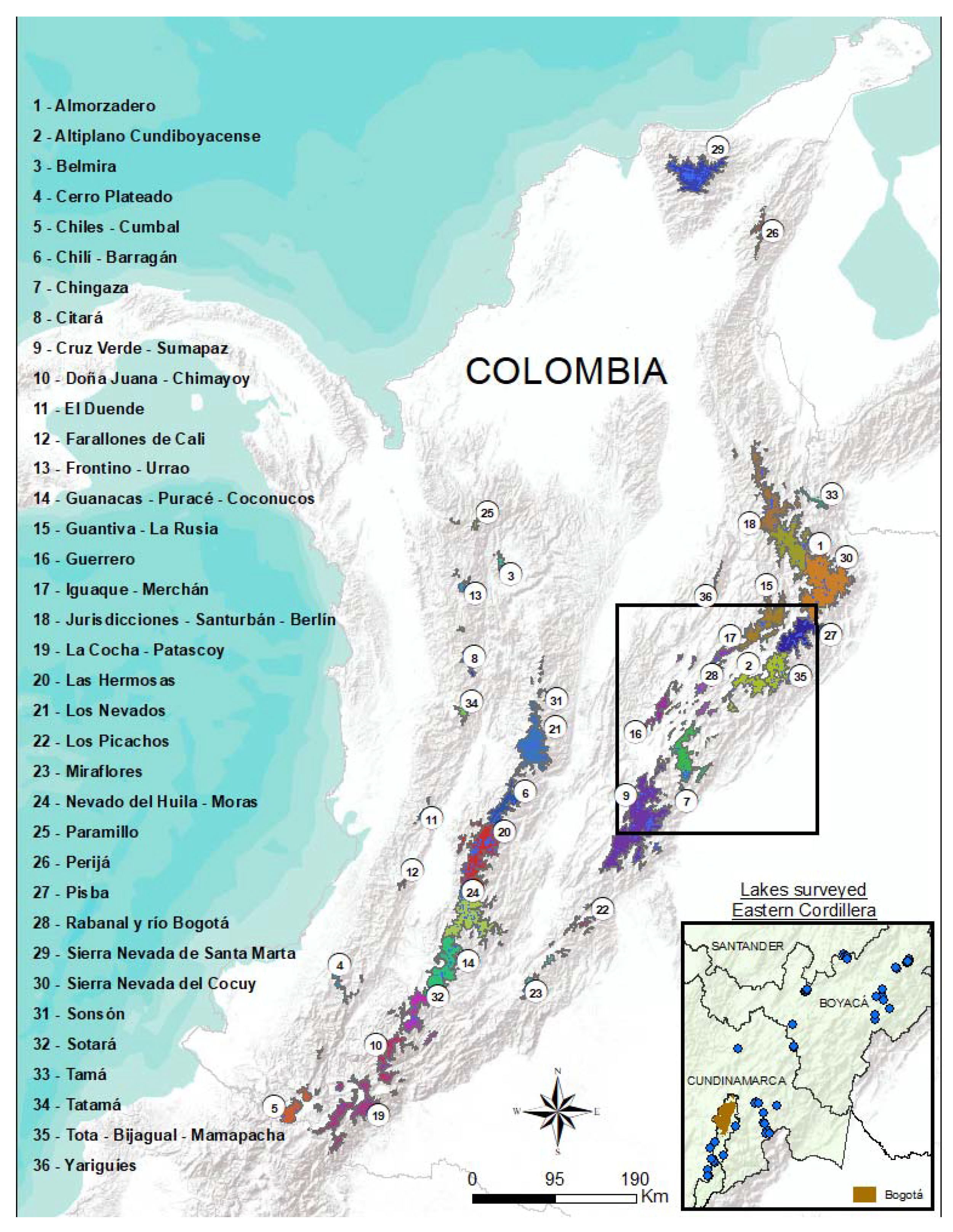
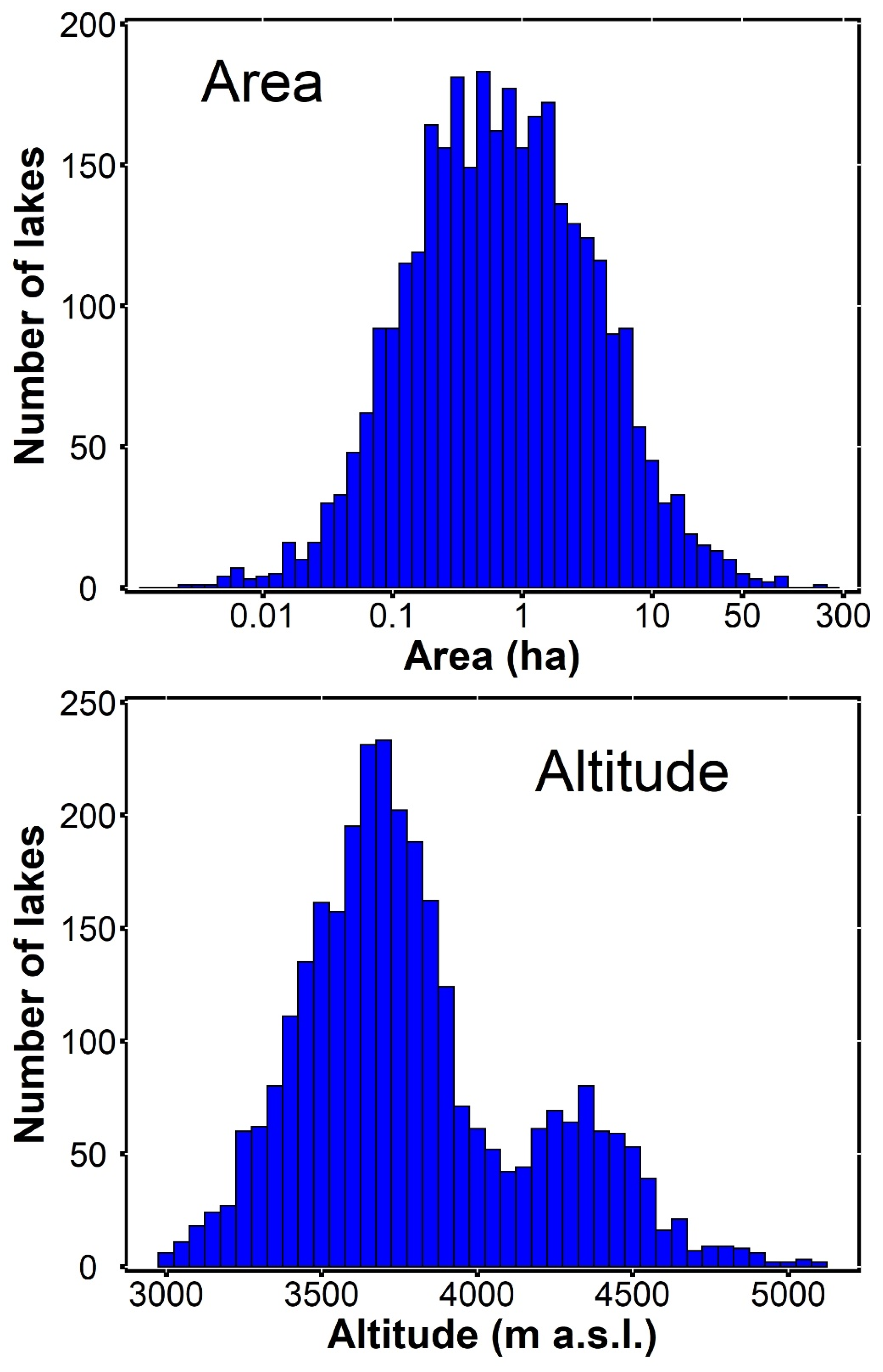
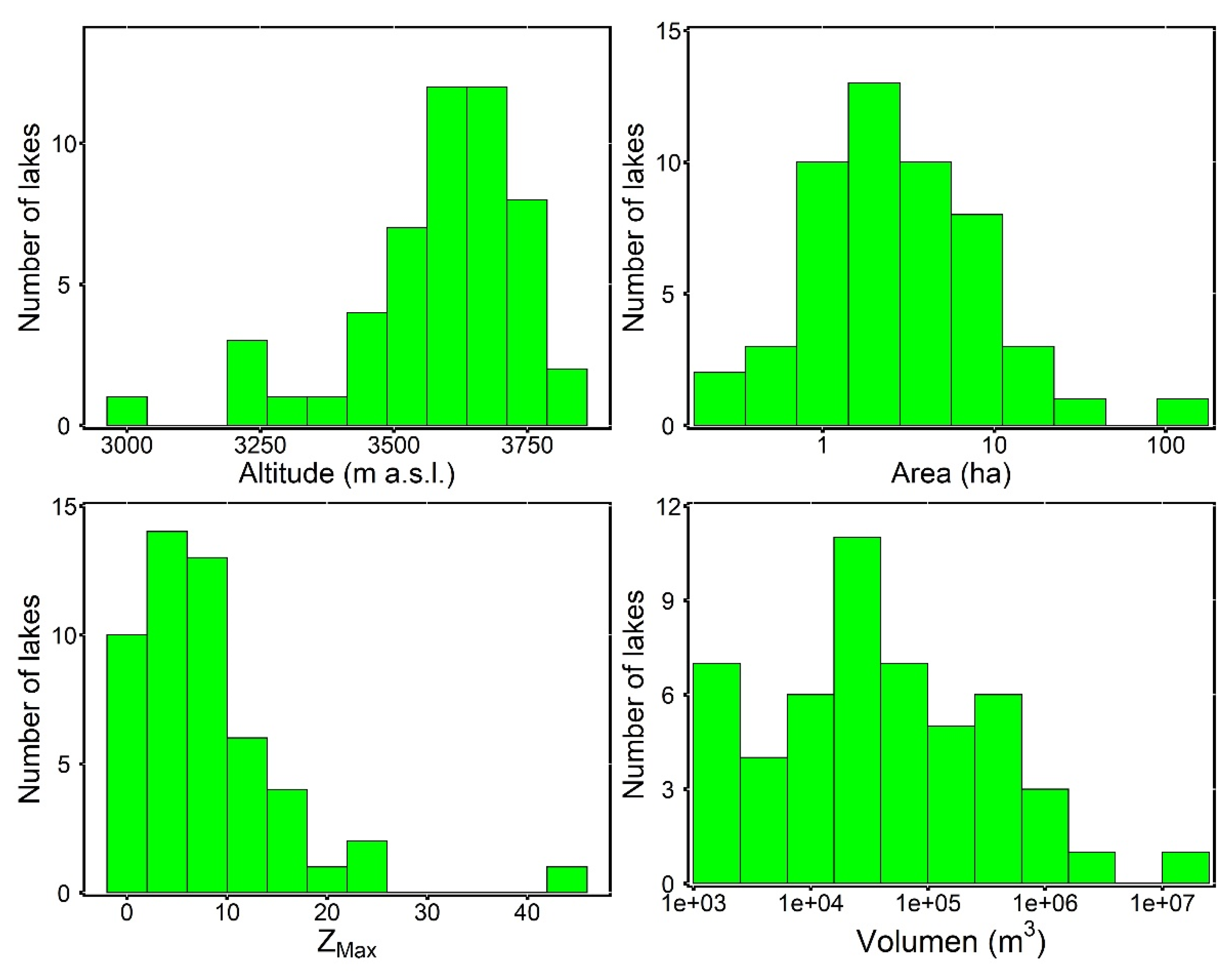
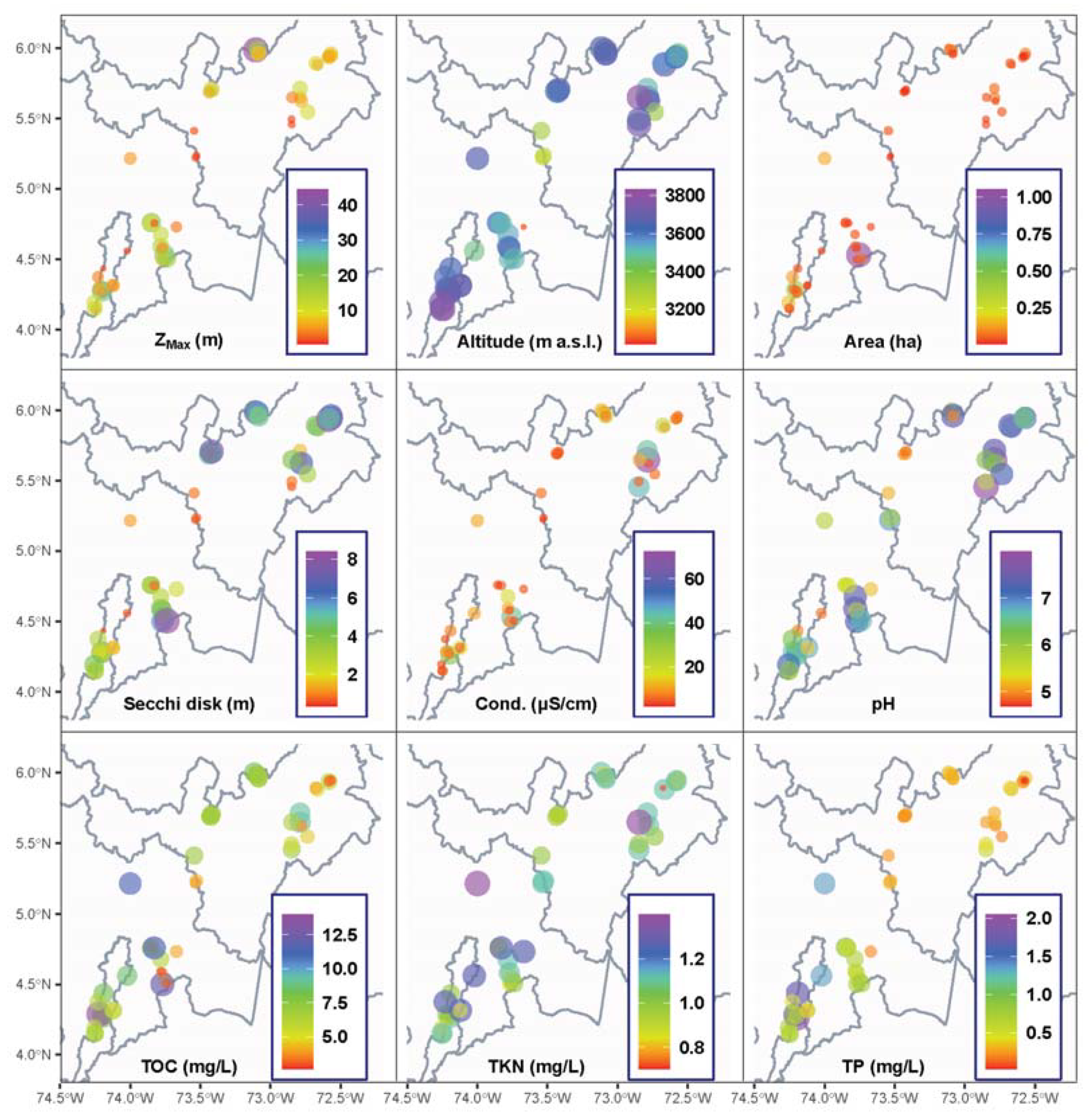
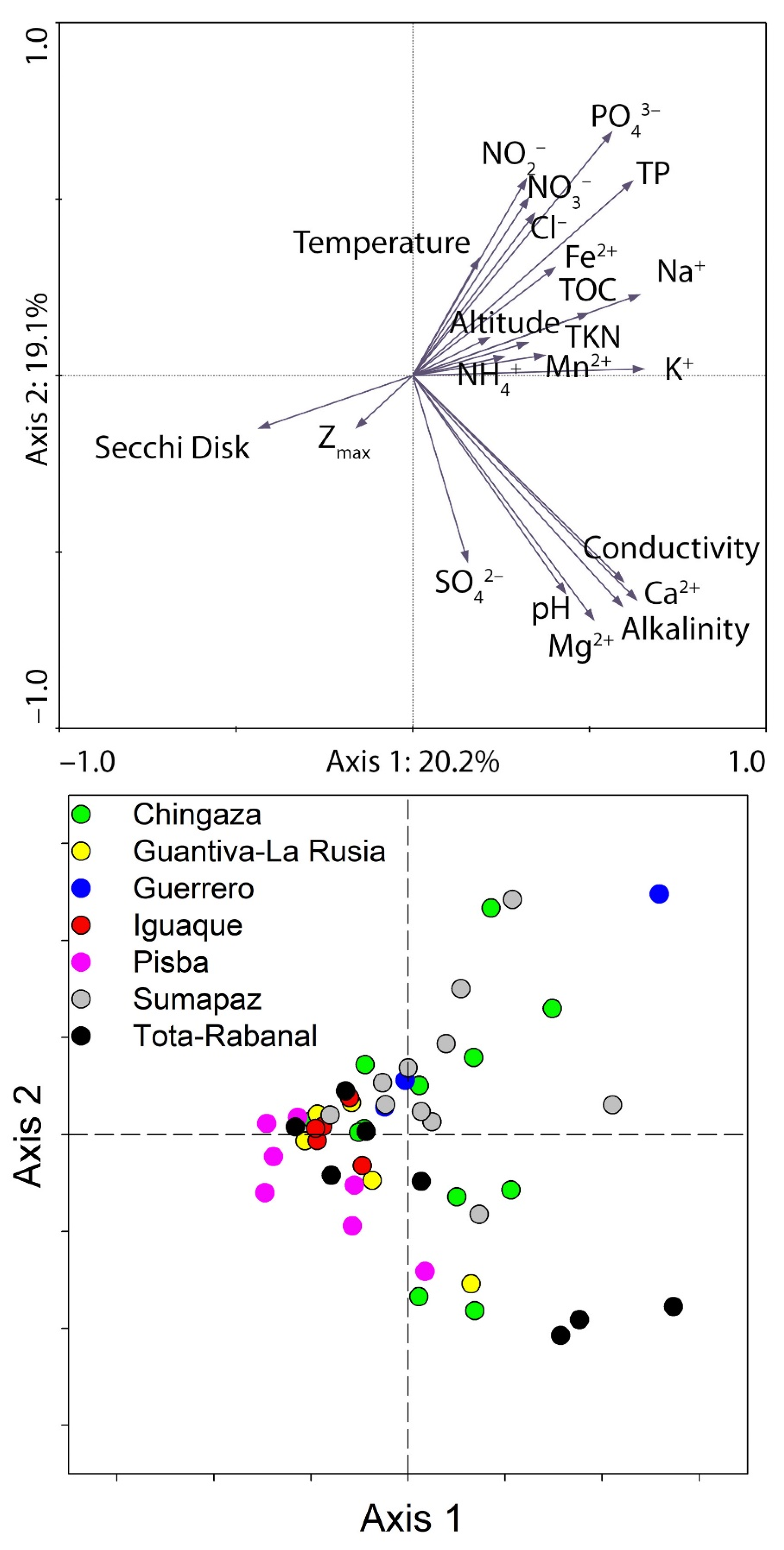
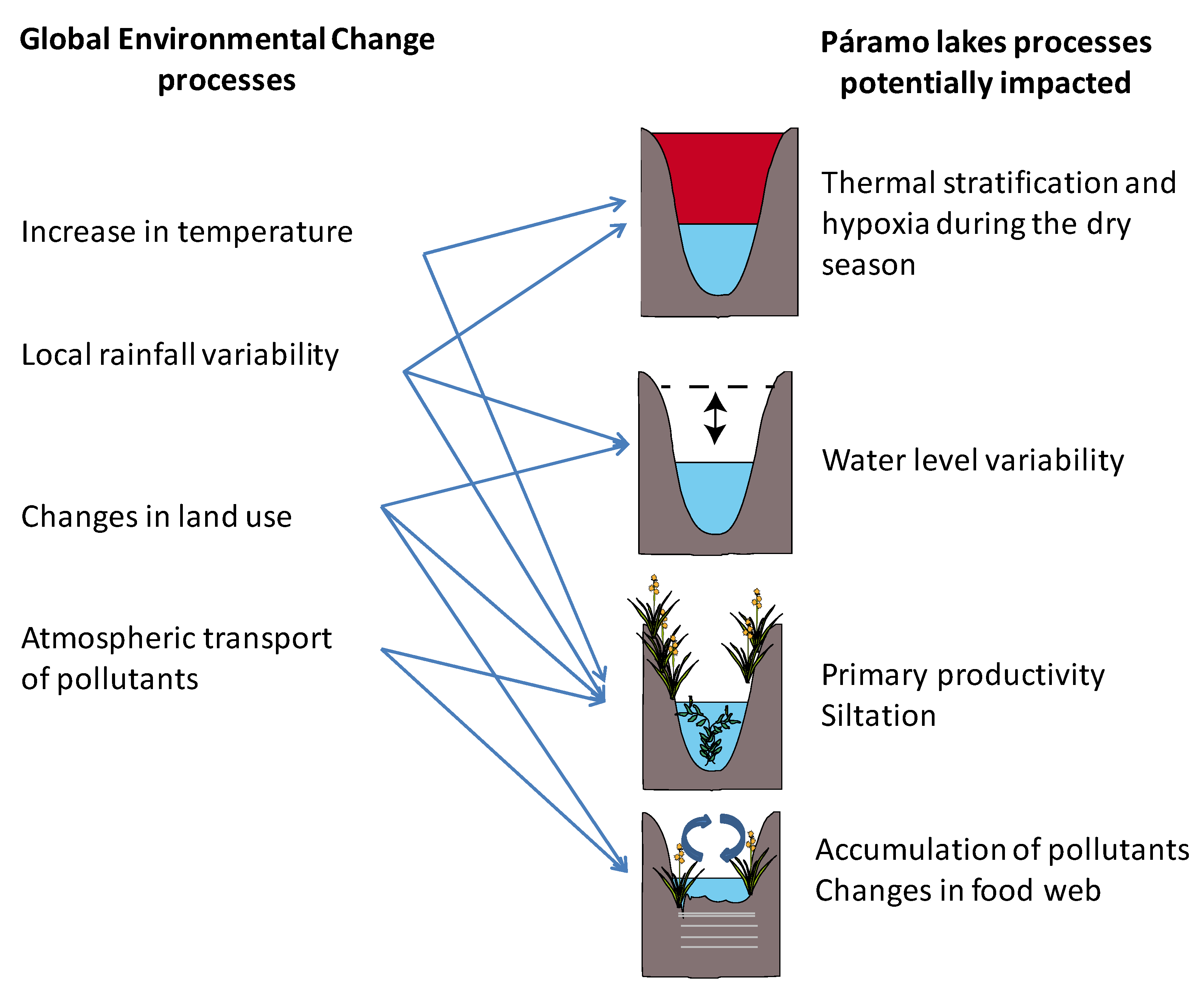
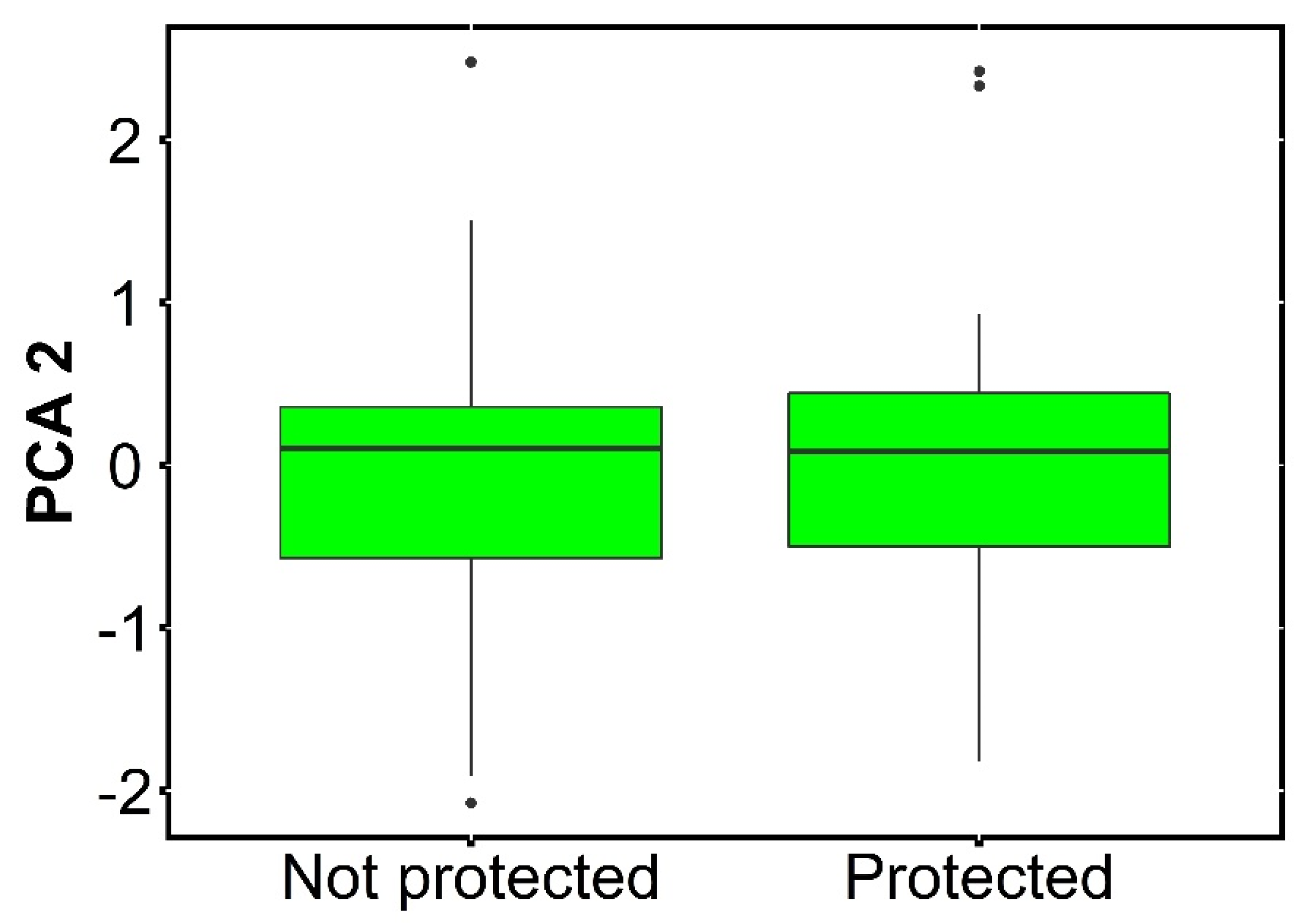
| ID | Páramo Complex | Sector | Total Páramo Area (ha) | Protected Fraction (%) | Protection under National Park System (%) | Number of Lakes | Number of Lakes in Protected Areas | Area Covered by Lakes (ha) |
|---|---|---|---|---|---|---|---|---|
| 1 | Almorzadero | Eastern C. | 156,552 | 0.4 | 128 | 301 | ||
| 2 | Altiplano Cundiboyacense | Eastern C. | 4657 | 4 | ||||
| 3 | Belmira | Western C. | 10,622 | 100 | 1 | 1 | 0.3 | |
| 4 | Cerro Plateado | Western C. | 17,070 | 17 | ||||
| 5 | Chiles-Cumbal | Nariño-Putumayo | 63,223 | 15 | 3 | 247 | ||
| 6 | Chilí-Barragán | Central C. | 80,708 | 29 | 78 | 11 | 267 | |
| 7 | Chingaza | Eastern C. | 109,956 | 73 | 44 | 124 | 103 | 245 |
| 8 | Citará | Western C. | 11,233 | 56 | 1 | 1 | 2 | |
| 9 | Cruz Verde-Sumapaz | Eastern C. | 333,420 | 52 | 42 | 324 | 220 | 1095 |
| 10 | Doña Juana-Chimayoy | Nariño-Putumayo | 69,263 | 50 | 35 | 28 | 10 | 65 |
| 11 | El Duende | Western C. | 4454 | 34 | ||||
| 12 | Farallones de Cali | Western C. | 4545 | 100 | 100 | |||
| 13 | Frontino-Urrao | Western C. | 13,921 | 85 | 8 | 2 | 2 | 7 |
| 14 | Guanacas-Puracé-Coconucos | Central C. | 137,677 | 23 | 23 | 81 | 39 | 285 |
| 15 | Guantiva-La Rusia | Eastern C. | 119,750 | 45 | 3 | 92 | 88 | 139 |
| 16 | Guerrero | Eastern C. | 42,325 | 75 | 71 | 51 | 65 | |
| 17 | Iguaque-Merchán | Eastern C. | 28,311 | 46 | 18 | 15 | 12 | 17 |
| 18 | Santurbán-Berlín | Eastern C. | 142,608 | 35 | 207 | 92 | 290 | |
| 19 | La Cocha-Patascoy | Nariño-Putumayo | 145,539 | 35 | 4 | 50 | 28 | 179 |
| 20 | Las Hermosas | Central C. | 208,011 | 64 | 55 | 526 | 429 | 1437 |
| 21 | Los Nevados | Central C. | 146,027 | 49 | 39 | 438 | 395 | 373 |
| 22 | Los Picachos | Eastern C. | 23,725 | 88 | 56 | 1 | 1 | 2 |
| 23 | Miraflores | Eastern C. | 19,928 | 85 | ||||
| 24 | Nevado del Huila-Moras | Central C. | 150,538 | 78 | 77 | 149 | 96 | 465 |
| 25 | Paramillo | Western C. | 6744 | 100 | 100 | 2 | 2 | 6 |
| 26 | Perijá | Eastern C. | 29,727 | 81 | 1 | 0.1 | ||
| 27 | Pisba | Eastern C. | 106,243 | 27 | 27 | 265 | 140 | 253 |
| 28 | Rabanal y río Bogotá | Eastern C. | 24,650 | 66 | 3 | 3 | 7 | |
| 29 | Sierra Nevada de Santa Marta | Sierra Nevada | 151,021 | 95 | 95 | 445 | 445 | 1600 |
| 30 | Sierra Nevada del Cocuy | Eastern C. | 271,033 | 65 | 65 | 78 | 47 | 576 |
| 31 | Sonsón | Central C. | 8707 | 40 | ||||
| 32 | Sotará | Central C. | 80,929 | 38 | 31 | 15 | 12 | 146 |
| 33 | Tamá | Eastern C. | 16,339 | 75 | 53 | 2 | 3 | |
| 34 | Tatamá | Western C. | 10,930 | 100 | 100 | |||
| 35 | Tota-Bijagual-Mamapacha | Eastern C. | 151,498 | 47 | 120 | 73 | 208 | |
| 36 | Yariguíes | Eastern C. | 4252 | 99 | 96 | |||
| Total | 2,906,137 | 50.8 | 33.3 | 3250 | 2303 | 8281 |
| Variable | Minimum | Maximum | Median | Mean | Coefficient of Variation |
|---|---|---|---|---|---|
| Altitude (m a.s.l.) | 3014 | 3830 | 3612 | 3580 | 0.05 |
| Area (ha) | 0.3 | 104.8 | 2.5 | 6.3 | 2.45 |
| Maximum length (m) | 77 | 1781 | 245 | 343 | 0.82 |
| Volume (×103 m3) | 1.0 | 13,303 | 38.6 | 438.6 | 4.28 |
| Zmax (m) | 0.4 | 44.3 | 6.3 | 8.2 | 0.97 |
| Zmean (m) | 0.1 | 17.0 | 1.8 | 2.8 | 1.18 |
| Secchi disk (m) | 0.3 | 8.4 | 3.2 | 3.5 | 0.64 |
| Photic index | 0.29 | 2.35 | 1.63 | 1.39 | 0.49 |
| Conductivity (µS/cm) | 2.0 | 72.0 | 5.0 | 10.7 | 1.26 |
| Surface temperature (°C) | 9.4 | 18.8 | 12.1 | 12.5 | 0.15 |
| Vertical temperature gradient (°C) | 0 | 4.2 | 1 | 1.21 | 0.94 |
| O2 at surface (mg/L) | 5 | 8.2 | 6.52 | 6.72 | 0.10 |
| O2 at bottom (mg/L) | 0 | 6.9 | 4.08 | 3.49 | 0.73 |
| O2 saturation at surface (%) | 78 | 117.1 | 99.9 | 99.0 | 0.10 |
| O2 saturation at bottom (%) | 0 | 110.6 | 56.6 | 50.5 | 0.74 |
| pH | 4.7 | 8.0 | 6.1 | 6.1 | 0.16 |
| Alkalinity (µeq/L CaCO3) | 6 | 848 | 30 | 100 | 1.56 |
| SO42− (mg/L) | 0.003 | 44.1 | 0.003 | 1.322 | 4.67 |
| Ca2+ (mg/L) | 0.17 | 7.82 | 0.62 | 1.38 | 1.38 |
| Mg2+ (mg/L) | 0.04 | 1.11 | 0.16 | 0.26 | 0.97 |
| Na+ (mg/L) | 0.37 | 1.73 | 0.66 | 0.73 | 0.33 |
| Mn2+ (mg/L) | 0.00 | 0.09 | 0.01 | 0.02 | 0.88 |
| K+ (mg/L) | 0.03 | 0.86 | 0.12 | 0.14 | 0.94 |
| Total Fe (mg/L) | 0.04 | 2.20 | 0.21 | 0.32 | 1.09 |
| Cl− (mg/L) | 0.03 | 3.73 | 0.18 | 0.34 | 2.03 |
| Total organic carbon (mg/L) | 2.6 | 14.0 | 6.2 | 6.3 | 0.40 |
| Total Kjeldahl nitrogen (mg/L) | 0.70 | 1.40 | 0.98 | 1.01 | 0.17 |
| NH4+ (mg/L) | 0.28 | 0.84 | 0.42 | 0.51 | 0.36 |
| NO3− (mg/L) | 0.001 | 0.179 | 0.007 | 0.016 | 1.83 |
| Total phosphorus (mg/L) | 0.02 | 2.05 | 0.40 | 0.55 | 0.79 |
| PO43− (mg/L) | 0.003 | 1.125 | 0.014 | 0.164 | 1.77 |
| Si (mg/L) | 0.13 | 3.75 | 1.20 | 1.37 | 0.62 |
Publisher’s Note: MDPI stays neutral with regard to jurisdictional claims in published maps and institutional affiliations. |
© 2021 by the authors. Licensee MDPI, Basel, Switzerland. This article is an open access article distributed under the terms and conditions of the Creative Commons Attribution (CC BY) license (https://creativecommons.org/licenses/by/4.0/).
Share and Cite
Zapata, A.; Rivera-Rondón, C.A.; Valoyes, D.; Muñoz-López, C.L.; Mejía-Rocha, M.; Catalan, J. Páramo Lakes of Colombia: An Overview of Their Geographical Distribution and Physicochemical Characteristics. Water 2021, 13, 2175. https://doi.org/10.3390/w13162175
Zapata A, Rivera-Rondón CA, Valoyes D, Muñoz-López CL, Mejía-Rocha M, Catalan J. Páramo Lakes of Colombia: An Overview of Their Geographical Distribution and Physicochemical Characteristics. Water. 2021; 13(16):2175. https://doi.org/10.3390/w13162175
Chicago/Turabian StyleZapata, Angela, Carlos A. Rivera-Rondón, Daivan Valoyes, Claudia L. Muñoz-López, Marino Mejía-Rocha, and Jordi Catalan. 2021. "Páramo Lakes of Colombia: An Overview of Their Geographical Distribution and Physicochemical Characteristics" Water 13, no. 16: 2175. https://doi.org/10.3390/w13162175
APA StyleZapata, A., Rivera-Rondón, C. A., Valoyes, D., Muñoz-López, C. L., Mejía-Rocha, M., & Catalan, J. (2021). Páramo Lakes of Colombia: An Overview of Their Geographical Distribution and Physicochemical Characteristics. Water, 13(16), 2175. https://doi.org/10.3390/w13162175






